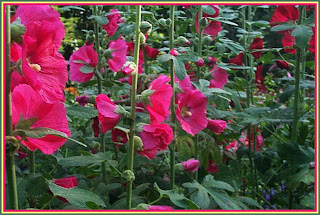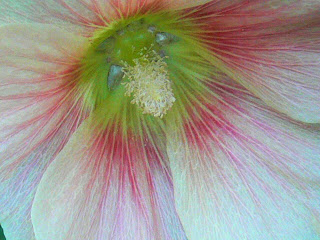
Monday, February 7, 2011
24° here on the mountain this morning. The sky is cloudy and there is a typical post-Super Bowl lull as if another calendar page has turned. A flock of red polls cover the feeders and the ground so thickly that even the greedy jays sit in the maples waiting their turn.
As Gail drops off a fresh coffee, she mentions that I better put the plow back on the truck. 4"-8" coming late today. We were spoiled by last winter and the early part of this winter when storms stopped along Route 4, 60 miles to our south. In recent weeks it has been one storm after another and cold enough that the snow hasn't come off the roofs. Rake and shovel as I may, I cannot seem to catch up.
The gardens are well covered in snow now and we are left with a garden of dreams save for leftover skeletons from hollyhocks or actaeas or ligularias. I still like this time as it forces me to remember what plants needed attention and what gardens need new additions.
I have been surprised by the number of catalogs that have arrived this year. We work hard to eliminate all but very few catalogs but the economy obviously suggests struggles for new customers. Some of the largest, most successful growers in America are in serious financial condition now, a direct result of the housing situation, and some have already folded. During a discussion with one of the growers we use, I asked about a shrub plant I was interested in. The grower said they had reduced the number of new plantings because of royalty fees on some of the new varieties and because of lack of projected demand two years out. Essentially the grower was saying that if you plant it and it doesn't sell, you still have to take care of it and if it gets too big before it sells, it becomes almost worthless.This is a lesson a home gardener has no reason to understand but it does impact on what is available.
To help us better understand what flower growers are planting, I signed Gail up for a membership with the Association of Specialty Cut Flower Growers. This is an association for field and greenhouse growers. I wanted to join for some time and I kept belaboring the annual membership. I finally wrote the check and in the first journal issue we have recouped the price in the new information we have learned. To make your garden of dreams current you have to get out and about and see what others are growing.
As you scan the catalogs that probably are arriving in your mailbox, pay close attention to growing conditions on the newer varieties. There are many new flowers to tempt you but some may not make it in your gardens no matter how much you wish they would. Also think twice before you buy those "big collections of perennials" with the cheap price tags or the two pound cans of wild flower mixes for $5. You will definitely receive something for your money but what will actually grow in subsequent years may be another question. Spending just a little more from a local grower will provide a source for planting instructions and a person to actually talk to. Buy local when you can!
 Writing from the mountain above Peacham Pond where a few snow flakes are falling and the red squirrels are reminding me that the sunflower seeds need replenishing!
Writing from the mountain above Peacham Pond where a few snow flakes are falling and the red squirrels are reminding me that the sunflower seeds need replenishing!
George Africa
The Vermont Gardener
Vermont Flower Farm
Social Networking Works!©
On Facebook as Vermont Flower Farm and Gardens and also as George Africa
On Twitter as vtflowerfarm
As Gail drops off a fresh coffee, she mentions that I better put the plow back on the truck. 4"-8" coming late today. We were spoiled by last winter and the early part of this winter when storms stopped along Route 4, 60 miles to our south. In recent weeks it has been one storm after another and cold enough that the snow hasn't come off the roofs. Rake and shovel as I may, I cannot seem to catch up.
The gardens are well covered in snow now and we are left with a garden of dreams save for leftover skeletons from hollyhocks or actaeas or ligularias. I still like this time as it forces me to remember what plants needed attention and what gardens need new additions.
I have been surprised by the number of catalogs that have arrived this year. We work hard to eliminate all but very few catalogs but the economy obviously suggests struggles for new customers. Some of the largest, most successful growers in America are in serious financial condition now, a direct result of the housing situation, and some have already folded. During a discussion with one of the growers we use, I asked about a shrub plant I was interested in. The grower said they had reduced the number of new plantings because of royalty fees on some of the new varieties and because of lack of projected demand two years out. Essentially the grower was saying that if you plant it and it doesn't sell, you still have to take care of it and if it gets too big before it sells, it becomes almost worthless.This is a lesson a home gardener has no reason to understand but it does impact on what is available.
To help us better understand what flower growers are planting, I signed Gail up for a membership with the Association of Specialty Cut Flower Growers. This is an association for field and greenhouse growers. I wanted to join for some time and I kept belaboring the annual membership. I finally wrote the check and in the first journal issue we have recouped the price in the new information we have learned. To make your garden of dreams current you have to get out and about and see what others are growing.
As you scan the catalogs that probably are arriving in your mailbox, pay close attention to growing conditions on the newer varieties. There are many new flowers to tempt you but some may not make it in your gardens no matter how much you wish they would. Also think twice before you buy those "big collections of perennials" with the cheap price tags or the two pound cans of wild flower mixes for $5. You will definitely receive something for your money but what will actually grow in subsequent years may be another question. Spending just a little more from a local grower will provide a source for planting instructions and a person to actually talk to. Buy local when you can!
 Writing from the mountain above Peacham Pond where a few snow flakes are falling and the red squirrels are reminding me that the sunflower seeds need replenishing!
Writing from the mountain above Peacham Pond where a few snow flakes are falling and the red squirrels are reminding me that the sunflower seeds need replenishing!George Africa
The Vermont Gardener
Vermont Flower Farm
Social Networking Works!©
On Facebook as Vermont Flower Farm and Gardens and also as George Africa
On Twitter as vtflowerfarm

























